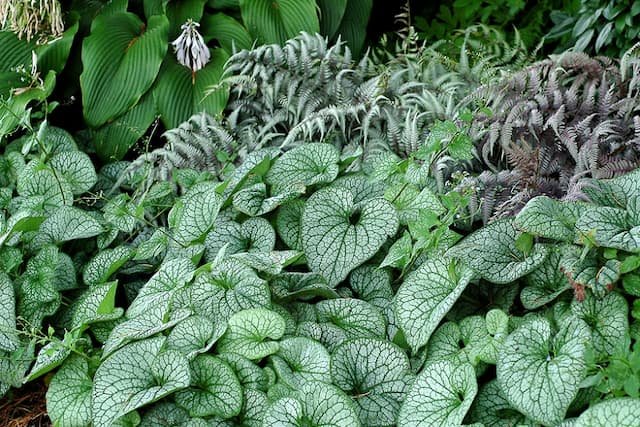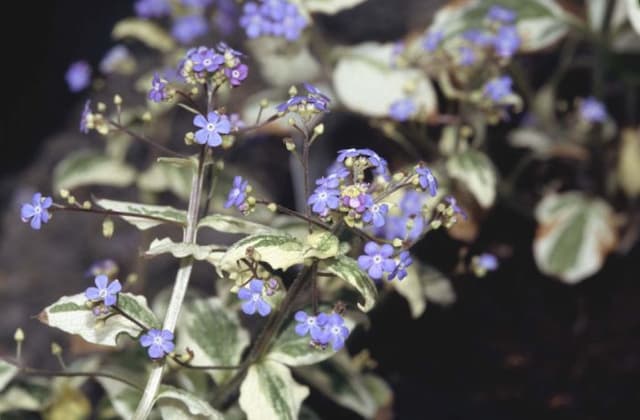Virginia Bluebell Mertensia virginica






ABOUT
Virginia bluebells is a perennial plant known for its showy and attractive spring blooms. It boasts smooth, oval to heart-shaped leaves that are gray-green in color and arranged alternately on the stem. These leaves often have a slightly wavy margin and can be quite lush, providing a soft backdrop for the flowers. The flowers of Virginia bluebells are the most distinctive feature, which appear in drooping clusters at the end of arched stems. Each blossom is bell-shaped, with a gentle flaring at the mouth, and usually about an inch long. The color of these flowers is a vivid, soft blue, although they may start off with pinkish or purple tones before fully maturing to their characteristic blue shade. The overall effect in bloom is often described as a blue haze over the area where the plants are growing. The plant is known for its ephemeral nature, meaning that it goes dormant in the summer after flowering and seeding.
About this plant
 Names
NamesSynonyms
Virginia Bluebells, Virginia Cowslip, Lungwort Oysterleaf, Roanoke Bells
Common names
Pulmonaria virginica, Pulmonaria caerulea, Mertensia pulmonarioides.
 Toxicity
ToxicityTo humans
Virginia bluebells (Mertensia virginica) are not known to be toxic to humans. There are no well-documented cases of poisoning from consuming or handling this plant.
To pets
Virginia bluebells are not typically known to be toxic to pets either. As with any non-food plant, ingestion in large amounts could potentially cause gastrointestinal upset, but Virginia bluebells are not known for containing any specific toxins that would cause poisoning in domestic animals.
 Characteristics
CharacteristicsLife cycle
Perennials
Foliage type
Deciduous
Color of leaves
Green
Flower color
Blue
Height
1-2 feet (0.3-0.6 meters)
Spread
1-1.5 feet (0.3-0.45 meters)
Plant type
Herb
Hardiness zones
3-8
Native area
North America
Benefits
 General Benefits
General Benefits- Attracts Pollinators: Mertensia virginica, commonly known as Virginia Bluebells, is a favorite of bees, butterflies, and other beneficial insects, helping to promote a healthy and diverse ecosystem.
- Aesthetic Appeal: With its beautiful blue-violet flowers, Virginia Bluebells can add stunning visual interest to gardens and naturalized areas.
- Wildlife Habitat: The plant provides shelter and food for wildlife, especially early in the spring when other food sources are scarce.
- Native Plant Advantages: As a native species, Virginia Bluebells is well-adapted to local climates and soils, making it a low-maintenance option for gardeners.
- Spring Interest: Its early blooming period helps usher in the spring and provides color after the winter season.
- Erosion Control: The root systems can help stabilize soil and prevent erosion in certain landscapes.
- Companion Planting: Virginia Bluebells pair well with other shade-loving plants and can be used effectively in woodland gardens.
- Naturalizing: It readily self-seeds and can create sweeping drifts of color over time in an appropriate setting.
 Medical Properties
Medical Properties- This plant is not used for medical purposes.
 Air-purifying Qualities
Air-purifying QualitiesThis plant is not specifically known for air purifying qualities.
 Other Uses
Other Uses- Dye production: Mertensia virginica can be used for natural dyeing, as different parts of the plant might produce subtle colors when used in fabric dyeing processes.
- Photography: The distinctive blue flowers of Virginia bluebells can be used as subjects in botanic photography and plant identification guides due to their striking appearance in springtime woodlands.
- Educational tool: Virginia bluebells can be included in educational programs about native plants, fostering an appreciation for local flora and natural habitats among students and garden visitors.
- Culinary use: The flowers, while not commonly consumed, are edible and can be used as a decorative and delicate garnish for salads and desserts.
- Butterfly gardening: This plant is beneficial for attracting pollinators such as butterflies, and can be included in butterfly gardens to provide nectar sources.
- Beekeeping: The nectar of Virginia bluebells is valuable for bees, making it a good plant choice for beekeepers looking to support their hives in early spring.
- Landscape restoration: As a native plant, Virginia bluebells can be used in landscape restoration projects to help reestablish natural plant communities and improve ecosystem services.
- Floral arrangements: While they don't have a long vase life, Virginia bluebell's blossoms can be used for creating ephemeral and delicate floral arrangements for events in spring.
- Mood photography: Due to their ephemeral nature and association with spring, Virginia bluebells make excellent subjects for photography aimed at capturing the mood of a season or an atmosphere.
- Art inspiration: The beauty of Virginia bluebells has inspired numerous artists to include the plant in painting, illustration, printmaking, and fabric design.
Interesting Facts
 Feng Shui
Feng ShuiVirginia Bluebell is not used in Feng Shui practice.
 Zodiac Sign Compitability
Zodiac Sign CompitabilityVirginia Bluebell is not used in astrology practice.
 Plant Symbolism
Plant Symbolism- Tranquility: Mertensia virginica, commonly known as Virginia bluebell, is often associated with soothing calmness and serenity due to its gentle blue-purple hue and delicate appearance.
- New Beginnings: Since Virginia bluebells are one of the early bloomers in spring, they symbolize the idea of new beginnings and the renewal of nature.
- Humility: The nodding habit of the Virginia bluebell's flowers can be perceived as a symbol of humility and grace.
- Constancy: The reliable reemergence of Virginia bluebells each spring can be seen as a representation of constancy and dependability.
 Water
WaterVirginia Bluebells should be watered deeply but infrequently, aiming for about 1 inch of water per week. This equates to approximately 0.623 gallons per square foot per week. During active growth in spring, ensure the soil remains consistently moist but not waterlogged. As they are spring ephemerals, once they die back in the summer, they require significantly less water. Cut back on watering when the leaves begin to yellow and the plant goes dormant.
 Light
LightVirginia Bluebells thrive in partial shade, with dappled sunlight being ideal. A spot under a deciduous tree is perfect, as it provides sun in the early spring when the tree's leaves are not yet out and shade during the heat of the summer when the plant goes dormant. They can tolerate more sun in cooler climates as long as they are kept moist.
 Temperature
TemperatureVirginia Bluebells prefer a temperate climate with temperatures ranging between 60 to 75 degrees Fahrenheit for optimal growth. They can survive minimum temperatures down to about 20 degrees Fahrenheit. However, they will become dormant and may require mulch for protection if temperatures consistently fall below freezing.
 Pruning
PruningPruning Virginia Bluebells usually involves removing spent flower stalks after blooming to prevent self-seeding if desired. It's also recommended to cut back the foliage after it has yellowed and died back in the late spring or early summer. Timing for pruning is typically after flowering and once the leaves show signs of dormancy.
 Cleaning
CleaningAs needed
 Soil
SoilVirginia Bluebell's best soil mix is rich, organic, moist, and well-draining with a pH of 6.0-7.5 to mimic its native woodland habitat.
 Repotting
RepottingVirginia Bluebells rarely need repotting and can be left undisturbed for several years unless they outgrow their space.
 Humidity & Misting
Humidity & MistingVirginia Bluebells thrive in average to high humidity levels, as found in their native woodland environments.
 Suitable locations
Suitable locationsIndoor
Keep in bright, indirect light and moist soil.
Outdoor
Partial shade, rich soil, and ensure soil remains moist.
Hardiness zone
3-8 USDA.
 Life cycle
Life cycleVirginian bluebells (Mertensia virginica) begin their life as seeds that, once dispersed, undergo a period of dormancy before germinating in favorable conditions such as moist, rich soils under the canopy of deciduous forests. The germinated seeds develop into small rosettes of leaves close to the ground, utilizing stored energy to grow. With the arrival of spring, these plants enter a rapid vegetative growth phase, producing larger leaves and elongating stems in preparation for flowering. Flowering typically occurs between March and May, when clusters of bell-shaped blue flowers bloom, attracting pollinators such as bees and butterflies. After pollination, the flowers develop into fruit capsules containing seeds, which are then dispersed by various means, including gravity and possibly animals. Following seed dispersal, the plant goes dormant again, with the above-ground parts dying back, while the underground rhizomes survive to sprout again the next spring.
 Propogation
PropogationPropogation time
Spring to early summer
Propogation: Virginia Bluebells (Mertensia virginica) are most commonly propagated by seed. To propagate by seed, one should collect the seeds shortly after they mature in late spring to early summer. The collected seeds can then be sown directly outdoors in the fall, which allows them to undergo a natural stratification process through the winter, which is essential for germination. Alternatively, if sowing seeds indoors, they must be stratified artificially by providing a cold period of about 60 days at temperatures of 33 to 41 degrees Fahrenheit (0.6 to 5 degrees Celsius) before sowing. This mimics the natural winter conditions the seeds would experience in the wild. Once stratification is complete and the seeds are sown, with proper conditions, they will germinate and can eventually be transplanted outdoors after the risk of frost has passed.









